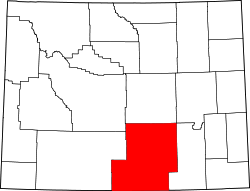City Landmark name location notes Arlington Old Rock Creek Stage Crossing Elk Mountain and Arlington Road near I-80 41°35′41″N 106°12′33″W / 41.5948°N 106.2093°W / 41.5948; -106.2093 Overland Trail crossing 1862-1868 [ 3] Elk Mountain Overland Trail Medicine Bow Road and Medicine Bow Ranger Station Road Wagon and stagecoach route through Wyoming and Colorado which connected with the Oregon Trail . [ 4] Elk Mountain Wagonhound Tipi Rings I-80 and Elk Mountain Arlington Road Prehistoric Native American campsite. Multiple markers at site. [ 5] [ 6] [ 7] Elk Mountain Old Cherokee Trail I-80 and Elk Mountain Arlington Road Trail ran from Oklahoma, Kansas, Colorado, and Wyoming that was used from 1840s to 1890s. [ 8] Elk Mountain Fort Halleck Rattlesnake Pass Road near I-80 41°41′56″N 106°31′23″W / 41.698900°N 106.523100°W / 41.698900; -106.523100 Built in 1862, west of the Medicine Bow River at the north base of the Elk Mountain after Henry Wager Halleck [ 9] [ 10] Encampment Grand Encampment 201 McCaffrey Avenue Site was rendezvous point of Indians and trappers. [ 11] Medicine Bow Owen Wister 405 Lincoln Hwy Wister wrote about pioneer Wyoming ranch life, wrote the 1902 novel The Virginian . [ 12] Medicine Bow United Air Lines Flight 409 Hwy 130 41°20′30″N 106°18′21″W / 41.341530°N 106.305860°W / 41.341530; -106.305860 Bronze memorial plaque was dedicated in the Miner's Camp turnout to the loss of Flight 409. [ 13] Medicine Bow Medicine Bow station 405 Lincoln Hwy Medicine Bow Union Pacific Depot was built 1912–1919. National Register of Historic Places. Multiple markers at the site. [ 14] [ 12] Medicine Bow George A. Wyman 405 U.S Highway 30 George A. Wyman was 1st to across America from San Francisco to New York City in 1903 on motor bike . [ 15] Muddy Gap Muddy Gap State Highway 220 and U.S. 287 42°21′44″N 107°26′35″W / 42.362200°N 107.442983°W / 42.362200; -107.442983 Muddy Gap at a crossroads on Oregon Trail. [ 16] Rawlins Rawlins Springs 201 5th Street In 1867, Grenville M. Dodge looking for a route for the Union Pacific Railroad , found Rawlins Springs. [ 17] [ 18] Rawlins Rawlins Paint Mines U.S. 287 near Gun Club Road Ancient reddish rocks, hematite mined from 1870 to the early 1900s. [ 19] Rawlins William Daley Flagpole 2415 West Pine Street In honor of pioneer William Daley (1844-1922) [ 20] [ 21] Rawlins Rawlins Paint Mines U.S. 287 near Gun Club Road Ancient reddish rocks, hematite mined from 1870 to the early 1900s. [ 19] Rawlins Northern Boundary of The Republic of Texas 904 West Walnut Street On April 21, 1836, General Sam Houston defeated General Antonio López de Santa Anna , granting Texas the Texas northern boundary of The Republic of Texas was in Wyoming. [ 22] Ryan Park Camp Ryan Park Camp Hwy 130 41°19′36″N 106°29′35″W / 41.326667°N 106.492944°W / 41.326667; -106.492944 Civilian Conservation Corps camp then World War II Prisoner of war (POW) camp. [ 23] Saratoga Thomas A. Edison State Highway 70 41°09′31″N 107°00′35″W / 41.158617°N 107.009717°W / 41.158617; -107.009717 Edison camped near this spot in 1878, while on a fishing trip. A bamboo fishing pole was used later for a lamp bulb filament . [ 24] Saratoga Saratoga World War II Veterans Memorial 113 East Bridge Avenue World War II US Army Veterans Memorial. [ 25] Saratoga Storer - Saratoga Lake Wetland Saratoga Lake Campground Road 41°28′29″N 106°47′30″W / 41.474600°N 106.791700°W / 41.474600; -106.791700 Wyoming Game and Fish Department wetland . [ 26] Saratoga Overland TrailPlatte River Crossing Wyoming Highway 130 41°36′52″N 106°48′55″W / 41.614350°N 106.815367°W / 41.614350; -106.815367 Overland Trail at the Platte River crossing, 1861 to 1868. [ 27] Seminoe Dam Seminoe Dam 42°09′21″N 106°54′30″W / 42.155833°N 106.908333°W / 42.155833; -106.908333 Seminoe Dam on North Platte River built in 1939 [ 28] Sinclair Fenimore Chatterton County Route 347 near I-80 41°46′28″N 106°56′50″W / 41.774383°N 106.947100°W / 41.774383; -106.947100 Sixth governor of Wyoming from 1903 to 1905. [ 29] Sinclair Civil War Cannons 498 Lincoln Avenue US Civil War Cannon use in oil field tank farm equipment. [ 30] Sinclair The Parco Inn 400 Lincoln Avenue 1925 Inn built by Fisher and Fisher for Frank Kistler, founder of the Producers & Refiners Corporation (PARCO), National Register of Historic Places and Historic district. [ 31] Sinclair Fort Fred Steele County Route 347 and I-80 41°46′42″N 106°56′51″W / 41.778333°N 106.947500°W / 41.778333; -106.947500 The fort was built in 1868, where the railroad crossed the North Platte River. Multiple markers at the site. [ 32] [ 33] [ 34] [ 35] Sinclair Post Trader's House Fort Fred Steele Post Trader's House at Fort Fred Steele. Multiple markers at site. [ 36] Sinclair Ranching Central Fort Steele 41°45′13″N 106°57′04″W / 41.753717°N 106.951017°W / 41.753717; -106.951017 Ranching industry sheep and cattle. Multiple markers at site [ 37] Sinclair Fort Steele Schoolhouse Fort Fred Steel 41°46′42″N 106°56′51″W / 41.778333°N 106.947500°W / 41.778333; -106.947500 Fort schoolhouse built in 1919. Multiple markers at site. [ 38] [ 39] [ 40] Sinclair Fort Steele Enlisted Men's Barracks Fort Fred Steel 41°46′42″N 106°56′51″W / 41.778333°N 106.947500°W / 41.778333; -106.947500 Enlisted Men's Barracks of Fort Steele. Multiple markers at site [ 41] [ 42] [ 43] [ 44] Wamsutter The Overland Stage Station Route State Highway 789 41°27′27″N 107°45′44″W / 41.457617°N 107.762300°W / 41.457617; -107.762300 The Overland Stage operated from 1862 to 1868, stopped at the Washakee Station. [ 45] Wamsutter Overland Trail State Highway 789 near I-80 41°27′28″N 107°45′44″W / 41.457800°N 107.762300°W / 41.457800; -107.762300 Overland Trail a busy trail in the 1860s for emigrants, freight and mail, and stagecoaches. Ran between the Missouri River and the west coast. [ 46] 
